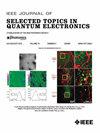路径长度选择,干涉漫射相关光谱学
IF 4.3
2区 工程技术
Q1 ENGINEERING, ELECTRICAL & ELECTRONIC
IEEE Journal of Selected Topics in Quantum Electronics
Pub Date : 2025-06-02
DOI:10.1109/JSTQE.2025.3575719
引用次数: 0
摘要
在这项工作中,我们提出了一种增强的漫射相关光谱(DCS)方法,称为路径长度选择性干涉DCS (PaLS-iDCS),它使用路径长度特异性相干增益来提高对深部组织血流动力学的敏感性和测量信噪比。通过干涉检测,pal - idcs可以提供飞行时间(ToF)特定的血流信息,而无需使用昂贵的时间标记电子设备和低抖动检测器。通过蒙特卡罗模拟、幻影实验和人体测量,将该技术与时域DCS (TD-DCS)进行了比较。TD-DCS是另一种增强的DCS方法,能够解决组织中的光子ToF。pal - idcs在相似的测量条件(相同的光子ToF)下始终显示出信噪比的改善(>2x),并且信噪比的改善允许在扩展的光子ToF下进行测量,这增加了对深部组织血流动力学的敏感性(增加了50%)。此外,与TD-DCS一样,PaLS-iDCS允许从采样的ToF分布中直接估计组织光学特性。该方法提供了一种相对直接的方法,使DCS系统能够对血流进行稳健的测量,大大提高了对深层组织血流动力学的敏感性,而无需时间分辨检测,从而使这种非侵入性技术的进一步应用成为可能。本文章由计算机程序翻译,如有差异,请以英文原文为准。
Pathlength-Selective, Interferometric Diffuse Correlation Spectroscopy
In this work, we present an enhanced diffuse correlation spectroscopy (DCS) method called pathlength-selective, interferometric DCS (PaLS-iDCS), which uses pathlength-specific coherent gain to improve both the sensitivity to deep tissue hemodynamics and measurement SNR. Through interferometric detection, PaLS-iDCS can provide time-of-flight (ToF) specific blood flow information without the use of expensive time-tagging electronics and low-jitter detectors. The technique is compared to time-domain DCS (TD-DCS), another enhanced DCS method able to resolve photon ToF in tissue, through Monte Carlo simulation, phantom experiments, and human subject measurements. PaLS-iDCS consistently demonstrates improvements in SNR (>2x) for similar measurement conditions (same photon ToF), and the SNR improvements allow for measurements at extended photon ToFs, which have increased sensitivity to deep tissue hemodynamics (∼50% increase). Further, like TD-DCS, PaLS-iDCS allows direct estimation of tissue optical properties from the sampled ToF distribution. This method offers a relatively straightforward way to allow DCS systems to make robust measurements of blood flow with greatly enhanced sensitivity to deep tissue hemodynamics without the need for time-resolved detection, enabling further applications of this non-invasive technology.
求助全文
通过发布文献求助,成功后即可免费获取论文全文。
去求助
来源期刊

IEEE Journal of Selected Topics in Quantum Electronics
工程技术-工程:电子与电气
CiteScore
10.60
自引率
2.00%
发文量
212
审稿时长
3 months
期刊介绍:
Papers published in the IEEE Journal of Selected Topics in Quantum Electronics fall within the broad field of science and technology of quantum electronics of a device, subsystem, or system-oriented nature. Each issue is devoted to a specific topic within this broad spectrum. Announcements of the topical areas planned for future issues, along with deadlines for receipt of manuscripts, are published in this Journal and in the IEEE Journal of Quantum Electronics. Generally, the scope of manuscripts appropriate to this Journal is the same as that for the IEEE Journal of Quantum Electronics. Manuscripts are published that report original theoretical and/or experimental research results that advance the scientific and technological base of quantum electronics devices, systems, or applications. The Journal is dedicated toward publishing research results that advance the state of the art or add to the understanding of the generation, amplification, modulation, detection, waveguiding, or propagation characteristics of coherent electromagnetic radiation having sub-millimeter and shorter wavelengths. In order to be suitable for publication in this Journal, the content of manuscripts concerned with subject-related research must have a potential impact on advancing the technological base of quantum electronic devices, systems, and/or applications. Potential authors of subject-related research have the responsibility of pointing out this potential impact. System-oriented manuscripts must be concerned with systems that perform a function previously unavailable or that outperform previously established systems that did not use quantum electronic components or concepts. Tutorial and review papers are by invitation only.
 求助内容:
求助内容: 应助结果提醒方式:
应助结果提醒方式:


